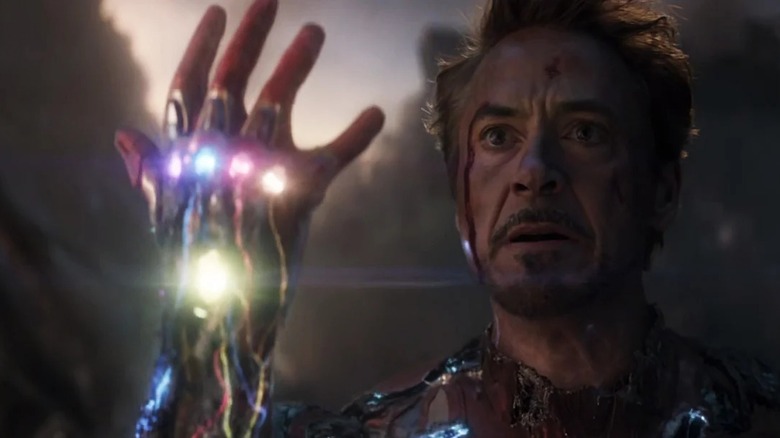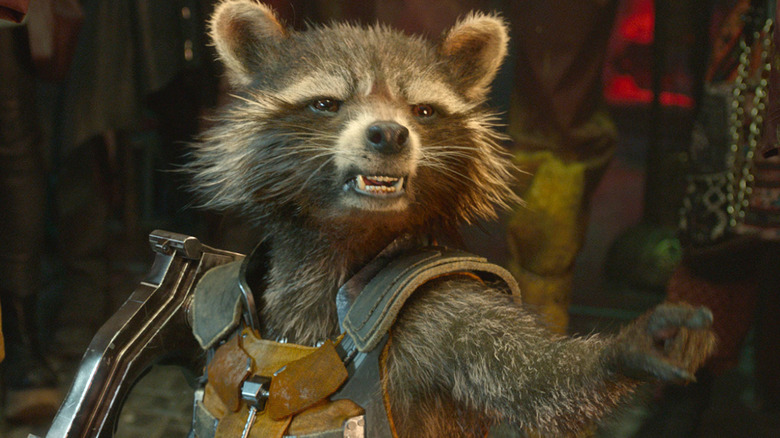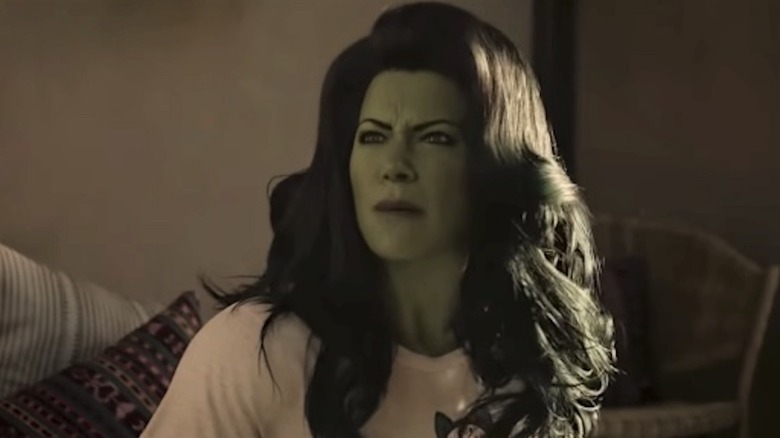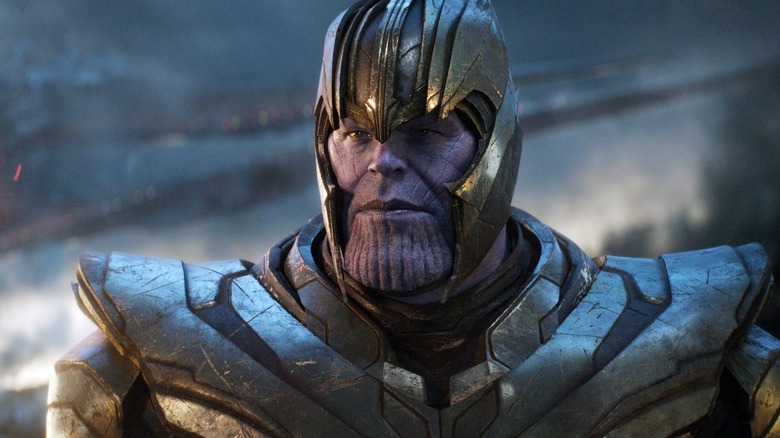In The MCU Era Of Hollywood, Is It Possible To Be A Movie Star?
In a recent interview with Allure, author Danielle Pergament read a text exchange she had with a co-worker to her interview subject, Jennifer Aniston. Pergament's colleague was wistful and bitter, saying "No one's ever going to be famous the way she is. That kind of mass-fame phenomenon burning so bright for so long, it's just not achievable today. She's like a silent-film star among a generation of TikTok dips***s." Aniston immediately agreed. "I'm a little choked up," she said. "I feel like it's dying. There are no more movie stars. There's no more glamour. Even the Oscar parties used to be so fun ..."
When Aniston was on the hit sitcom "Friends" (1994 – 2004), she and her co-stars were famously able to negotiate the biggest paydays in television history, netting $1 million per episode. The cast knew that "Friends" was reliant on their unique chemistry, and also that it was one of the most watched TV shows on the air. They essentially told the studio to prove how indispensable they were. As a result, six actors became very, very rich in addition to already being very, very famous.
The fact that there are no more movie stars is, in fact, quite an old notion. Ethan Hawke expressed similar trepidation in an AV Club interview back in July. Screencrush had been ringing the same bell since 2016. Forbes ran an article back in 2013, declaring that the age of the Movie Star was already over. Not incidentally, I myself made the same comment back in 2015. It's now a cliché to even mention that "movie stars" no longer open movies. And, in 2022, it's now more true than ever.
What is a movie star?
Aniston, of course, refers to an ineffable sense of glamour when referring to "movie stars." She seems nostalgic for a time when being rich and famous carried with it an element of perceived sophistication. The word "cosmopolitan" wasn't just the name of a fashion magazine or a Cointreau-based cocktail, but an adjective referring to worldliness. Aniston sees "movie stars" as living in those Olympian circles, eager to appear "classy." Not to speak for Aniston, but it seems that, to her eyes, "glamour" has been replaced with bubbly, homemade, teen TikTok celebrities who are eager to behave in a fashion that the older generation might describe as "gauche."
But "movie star" doesn't necessarily refer to the spending habits and public appearances of the upper crust. "Movie star" is, of course, a broadly applied term that — to offer a potentially universal definition — alludes to the glory days of Hollywood's Gold Age, specifically the 1940s. There was a time when actors would serve as contract players for big studios, having proven themselves as bankable box-office draws. Many films of the era were sold by their stars and not necessarily for their content. A movie star was any actor whose very presence in a film could boost its success. One didn't just see "Casablanca." One saw a Humphrey Bogart movie. This is a model that held true for decades.
The first steps of the MCU
To blend the two above definitions into something more accurate: a movie star is someone who can indeed "open" a picture, but also someone whose natural, dazzling qualities are more important than their talent. Movie stars can, of course, be talented actors, but their appeal has more to do with their natural personality and sparkling "it" qualities than their abilities to act, sing, or dance well. Arnold Schwarzenegger is a great movie star, but he is not a great actor. A movie star sits at an intersection of personality-based glamor and widespread bankability.
Think back to 2009, when Disney bought Marvel.
Ever since the advent of the Marvel Cinematic Universe, of course — to site the most publicly visible cultural fulcrum — one can see the importance of movie stars waning. While actors like Chris Evans and Chris Hemsworth and handsome and charming people, it wasn't because of them that audiences wanted to see Joe Johnston's "Captain America: The First Avenger" or Kenneth Branagh's "Thor." Audiences went to see the characters they play. One might point to an undefinable alchemy in place when someone like Hemsworth or Evans plays a notable Marvel hero or villain, putting in a unique performance and "making the part their own," as critics might say. But it's not so hard to imagine any number of handsome, reasonably talented men in those same roles gaining the same amount of fan traction. With the MCU, characters and properties became more vital than the people playing them.
The rise of the cinematic universe
Additionally, the MCU had, with the release of "Iron Man 2," begun an openly touted plan to make a series of interconnected movies, making it one of the more ambitious film projects of all time. The press releases had already been published, and audiences were eager to see how several movies, released over the course of three years, would interconnect. One might theorize that "Thor," had it not come with the known imprimatur of other films to follow, would not have been as successful. So the thirst for the MCU wasn't just character-based, but universe based. The characters were fine, but watching them interact was the true appeal of the series.
The phrase "cinematic universe" was introduced to the lexicon, and it became the new release structure for many, many movies. Even movies that didn't warrant interconnectivity inserted hints at "larger things" in the wake of the MCU. Remember when "Scoob!" included the Blue Falcon? Or when Sony announced a Ghostbusters universe? Or the Dark Universe? Clearly, interconnectivity was ruling the roost.
It's notable, though, that the initial wave was sparked by a superhero universe of fantasy characters in masks. Because the characters and the structure was more important than the actors, Marvel was free to cover their faces. An actor in a mask can be animated. The actor isn't strictly needed. Indeed, if an actor is needed again, they can now be recreated with CGI. Remember the fake Mark Hamill in "The Mandalorian" or the fake Carrie Fisher/Peter Cushing in "Rogue One"? One of Disney's hottest shows features a character who never removes his mask looking after a puppet.
Training us how to think
Thanks to the MCU, the audience has been trained to think quite differently about their "movie stars." While it's exciting that certain actors may be stepping into notable roles, ultimately, their casting carries with it a distantly resigned feeling of "they'll do," rather than "they'll do great."
If they don't work, reboot the series. Keep on drinking potent shots of novelty. The character will carry you through, and debates can be had over who played the best Spider-Man, as if the actor was at all significant.
In recent films, the MCU has gone one step further by dabbling with The Multiverse. Thanks to a new cure-all plot conceit, characters from other continuities can be united to interact as they did in "Spider-Man: No Way Home." Given that film's massive success, audiences are clearly eager to see all of their favorites pressed together and preserved like flowers in a Victorian teen's diary. The characters are now nostalgia baubles that co-exist with the modern-day renditions. And because audiences are so fond of multiverses, studios are now free to recast or resurrect whatever characters they want ... provided it's under the conceit that they popped through a dimensional fissure. No one will die. There are no consequences. Actors can come and go.
It's the universe and the nostalgia that matter. Audiences have been trained to accept recasting. When an actor can be "swapped out" at a moment's notice, becoming attached to a singular movie star is churlish.
This may be why there are no movie stars. Audiences no longer see actors as permanent, vital fixtures of their favorite movies. Thanks to the massive architecture of the Cinematic Universe and the pliability of fantasy character-based entertainment, there is no longer a need for them.




